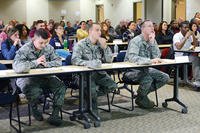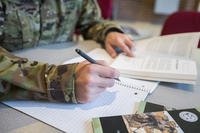Class of 2014 results show students who were on target for readiness on PSAT/NMSQT® but fell short on SAT®; early action could keep these students on target
PSAT/NMSQT results identify hundreds of thousands of students in the class of 2016 with potential to succeed in AP® courses
NEW YORK – For the first time ever, the College Board released results from three of its programs – PSAT/NMSQT, SAT, and Advanced Placement Program® (AP®) – in a combined manner. The national and state-level results paint a more complete picture of student progress during high school, showing missed opportunities for just-graduated students and areas where action can be taken to improve student outcomes for those still in high school.
The combined results build on the College Board's work to move beyond delivering assessments to delivering opportunity.
In September 2013, the College Board released results for the SAT class of 2013 and cited stagnant performance as a call to action to increase college and career readiness. In partnership with its members, the College Board has since engaged in an in-depth analysis of how its programs could be used to increase opportunity.
Following the 2013 results, on March 5, 2014, the College Board made a commitment to a redesigned SAT focused on the skills and knowledge evidence shows matter most for college and career success. The redesigned SAT will first be administered in March 2016.
With this year's results, College Board leaders affirmed the organization's commitment to action:
David Coleman, College Board president and CEO: "For a long time, institutions like ours have been reporting that too many students aren't ready for college and career workforce training. It's time to do something about it. We at the College Board are transforming what we do to advance opportunity, including refocusing our assessments on what matters most and providing free supports for all students. Offering the same old test in the face of lasting problems is just not good enough."
Cyndie Schmeiser, College Board chief of assessment: "The latest SAT results reaffirm that we must address the issue of preparedness much earlier and in a more focused way. Students in the class of 2014 missed opportunities that could have helped more of them to make successful transitions to college and career. The College Board is working toward solutions that will advance readiness and success for all students."
Trevor Packer, College Board senior vice president, AP and Instruction: "The College Board remains committed to ensuring all students with the potential to succeed in AP courses are able to access those opportunities. Research clearly shows that challenging coursework in high school is a vital component in helping students succeed as they transition to college and beyond."
PSAT/NMSQT Results: Insights into Opportunities
The PSAT/NMSQT is the linchpin among the College Board programs and plays a critical role in the College Board's work to improve student outcomes. It is the nation's largest and most representative pre-college assessment and provides valuable early information about student progress.
- In 2013-14, a record 3.7 million students took the PSAT/NMSQT. Of these, 1,678,760 (45.9 %) were minority students.
PSAT/NMSQT results are also the best predictor of a student's potential to succeed in certain AP courses – identifying students with a high likelihood of succeeding in particular AP subjects as early as 10th grade, and providing actionable feedback to help educators, parents, and students address any deficiencies in student preparation.
PSAT/NMSQT results show in the public high school class of 2014, almost four out of 10 students with AP potential did not take an AP course for which they showed likelihood of success.
- In the class of 2016, nearly a half a million (491,508) students who took the PSAT/NMSQT in October 2013 show potential to succeed in AP courses. Among public school students, 381,792 show potential. For context, 38.3 % of public school students in the class of 2016 took the PSAT/NMSQT in October 2013.
By identifying potential for more students early, we can help them take advantage of opportunities they have earned.
SAT Results: Opportunities Missed in the Class of 2014
The SAT is a key piece of the college admissions process. A look at the SAT class of 2014 shows an increase in overall participation – including among minority students and students who took the exam using a fee waiver.
- 1,672,395 students from the class of 2014 took the SAT, an increase compared to 1,660,047 students last year.
- 793,986 students were minority students — an increase from 762,511 last year.
- 394,992 students took the exam using a fee waiver, an increase from 387,748 last year.
However, overall performance remained stagnant. Only 42.6 % of SAT takers in the class of 2014 met the SAT College and Career Readiness Benchmark.
The SAT College and Career Readiness Benchmark represents those students who are likely to be ready to take college-entry, credit-bearing courses and not need remediation. This number has remained virtually unchanged over the last several years.
This readiness challenge remains especially acute among underrepresented minority students:
- 15.8% of African American SAT takers met the benchmark.
- 23.4% of Hispanic SAT takers met the benchmark.
- 33.5% of Native American SAT takers met the benchmark.
These numbers are also stagnant when compared to last year's readiness percentages.
Students in the SAT class of 2014 missed opportunities that could have helped them make successful transitions to college. A look at both PSAT/NMSQT and SAT results reveals a group of students who fell off target between the time they took the PSAT/NMSQT and the SAT.
- Of the 1.67 million SAT takers who graduated in 2014, just over 609,000 took the PSAT/NMSQT in the fall of their junior year and the SAT in the fall of their senior year. Over 29,000 (5%) of these students were on target for college and career readiness in the 11th grade but fell off target by the fall of their senior year.
There was also a group of test-takers in the SAT class of 2014 who were close to meeting the SAT Benchmark.
- 9% (157,417) of the 1.67 million SAT takers who graduated in 2014 were within one year's growth of being on target for college and career readiness.
AP: Areas of Promise
AP courses offer students the opportunity to pursue college-level coursework while still in high school. Access to challenging course work in high school is a key part of ensuring successful transitions to college and careers.
Currently, the majority of U.S. students who enter four-year colleges do not graduate within four years, spending extra time and money to attain a bachelor's degree. New research shows that students who have taken at least one AP exam, including those that score a 1 or 2, are more likely to graduate college on time than academically matched peers who did not take AP. Students who score a 3, 4, or 5 on AP Exams have the potential to save time and money through credit-granting policies at more than 3,900 colleges and universities in the United States.
A look at the May 2014 AP Exam administration shows:
- 1,478,084 11th and 12th grade public school students took AP in 2014, an increase of 3.8% from last year.
- 408,808 were traditionally underrepresented minority students, an increase of 7.0% from last year.
- 355,379 were low-income students, an increase of 7.3% from last year.
Overall, 21.9 % of public high school 11th- and 12th-graders took an AP Exam last year. However, gaps continue to persist – some small and some large.
- 19.1 % of Hispanic students, 12.9 % of African American students, and 12.0% of Native American students took an AP Exam last year.
Access to AP is particularly important for underserved students because of the ways AP classes connect students to college majors and careers. For example, research finds that African-American and Hispanic students who take AP STEM coursework are 2 - 4 times more likely than their peers to major in related STEM disciplines.
Notably, educators have achieved a steady increase in the percentage of students who earn high AP Exam scores of 3, 4, or 5 before leaving high school.
- The percentage of the nation's public high school 11th- and 12th graders succeeding on at least one AP Exam has nearly doubled over the past decade from 7.6% in May 2004 to 13.2% in May 2014.
The College Board Readiness and Success System
The College Board believes in demanding more from assessments so that they inspire productive practice and support students who are behind. Prior to the administration of the redesigned SAT in spring 2016, the redesigned PSAT/NMSQT will launch in October 2015 alongside a redesign of the College Board's eighth/ninth-grade assessment.
Focused on the few skills that evidence shows matter most for college and career success, all of these assessments – components of the College Board Readiness and Success System – will provide more actionable results for students and educators beginning in middle school. These results will include monitoring student progress toward college and career readiness, identifying skills that need strengthening, and connecting student performance to practice.
Last March, the College Board committed to confronting inequities driven by high-cost test preparation by partnering with Khan Academy to develop free, world-class practice to help students of all backgrounds prepare for the redesigned SAT. In addition, the College Board is developing high quality, free resources, including career planning tools, to support students in the earlier years of critical preparation in middle school and high school.
The College Board's commitment to action also extends to helping students overcome financial barriers that prevent them from successfully transitioning to college and career. Currently the College Board contributes approximately $78 million in program fee waivers to students each year. And with the support of colleges and universities, the College Board recently launched the College Application Fee Waiver Program to directly provide four college application fee waivers to every income-eligible senior who takes the SAT or SAT Subject Test using a fee waiver.
Through its SAT School Day program, the College Board is also working with state and district partners to give students the option to take the SAT during the school day at the district or state's expense. The program is especially beneficial for those students who otherwise might not be able to travel to a test center on a national weekend test date. Research examining state supported SAT administrations has shown that increasing student access to the SAT has resulted in higher college-going rates, particularly among students who would not have considered college otherwise.
Working closely with members and partner organizations, we've also launched a series of initiatives to ensure that students who have demonstrated the potential to succeed in AP courses are able to access them. These efforts include:
- The All In campaign, developed to ensure that 100 % of African American, Latino, and Native American students with AP potential enroll in at least one AP class in a subject for which they've shown potential;
- The AP STEM Access program, an initiative created in partnership with Google and DonorsChoose.org that is providing 10,000 additional minority and female students with access to participate in AP STEM courses; and
- AP Opportunity program, which will enable 70 schools across the nation to start nearly 140 new AP courses and expand access to academically prepared low-income students
Reflecting on these results, College Board President and CEO David Coleman said, "The College Board won't stand still with the same test and the same program while student readiness results are far too low and unchanging. The College Board will redouble its work to challenge students to focus their efforts, practice hard, and remove the barriers in their way."
About the College Board
The College Board is a mission-driven not-for-profit organization that connects students to college success and opportunity. Founded in 1900, the College Board was created to expand access to higher education. Today, the membership association is made up of over 6,000 of the world's leading educational institutions and is dedicated to promoting excellence and equity in education. Each year, the College Board helps more than seven million students prepare for a successful transition to college through programs and services in college readiness and college success — including the SAT® and the Advanced Placement Program®. PSAT/NMSQT is a registered trademark of the College Board and National Merit Scholarship Corporation. The organization also serves the education community through research and advocacy on behalf of students, educators, and schools.





